Measuring Performance
Outcome 1: Accessible, reliable and safe public transport system
EFFICIENCY INDICATORS
The PTA’s effectiveness in providing a cost efficient public transport system is measured using the following key efficiency indicators:
- Average cost per passenger kilometre
- Average cost per 1,000 place kilometres
- Total Passenger place kilometres (millions)
Note: Due to the abolition of the Capital User Charge (CUC) in 2007/08, the costs for calculating the efficiency indicators in 2007/08 exclude CUC compared to the previous years (where CUC was included) 2004/05 to 2006/07. Where the CUC amounts are material, a comparison graph excluding CUC for the previous three years is provided
1. Average cost per passenger kilometre
This indicator measures the cost efficiency of providing passenger services, expressed as the cost of carrying one passenger one kilometre.
Passenger kilometres are currently based on the zonal distribution of passenger trips and an assumed average trip length for each zone.
The indicator measures the cost efficiency of the services, i.e. the trend in the cost of carrying one passenger over one kilometre. A declining trend indicates that the resources used to provide the services are being utilised in a cost efficient manner.
Transperth train services
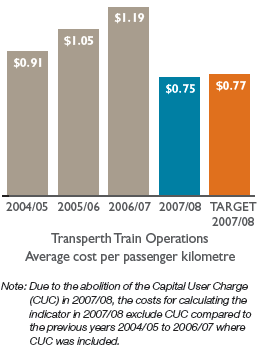
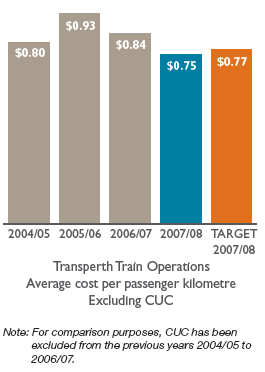
The average cost per passenger kilometre (excluding CUC) fell 10.7% in 2007/08 compared to 2006/07 and was 2.6 % below the target.
Following the opening of the Mandurah Line in December 2007, fare-paying boardings rose 25.6% over 2006/07 and resulted in passenger kilometres increasing 35% from 271.567 million in 2006/07 to 366.639 million in 2007/08. The increase in passenger kilometres combined with a lower percentage increase in costs of 21.72% from $227.398 million (excluding CUC of $94.881 million) in 2006/07 to $276.780 million in 2007/08 contributed to the decrease in the average cost per passenger kilometre in 2007/08.
The average cost was below target as the target was based on 375.6 million passenger kilometres and projected total costs of $288.7 million on the assumption that the Mandurah Line would start operations in August 2007.
Note that passenger kilometres are estimated using the zonal distribution of fare-paying boardings, therefore the calculated average trip length may not be accurate. In future it is intended to use the SmartRider tag-on/tag-off functionality to determine a more accurate average trip length on train.
Transperth bus services
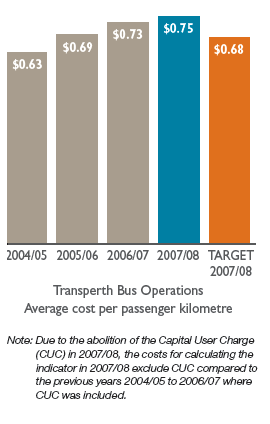
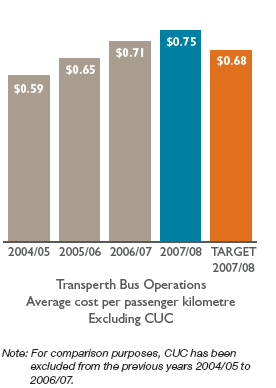
Total cost per passenger kilometre on the bus network (excluding CUC) increased by 5.6% in 2007/08 compared to 2006/07 and was 10.3% above target. While fare-paying boardings on bus increased by 1.4%, more services and longer trip distances on bus feeder services to the Mandurah Line led to a 3.1% increase in bus passenger kilometres, from 350.136 million in 2006/07 to 361.033 million in 2007/08. However the increase in patronage and passenger kilometres did not keep pace with cost increases. Total costs rose 10.3% from $246.860 million (excluding CUC of $7.182 million) to $272.315 million resulting in the average cost per passenger kilometre exceeding the target for the year and the 2006/07 result. The increase in costs was due to the increase in fuel costs and a 4.3% increase in wage costs. There were also cost increases associated with the introduction of the extensive bus feeder network in the southern suburbs.
The target was based on 383.9 million passenger kilometres expected to be achieved if the Mandurah Line commenced operations in August 2007 and projected total costs of $260.8 million.
Note that passenger kilometres are estimated using the zonal distribution of fare-paying boardings, therefore the calculated average trip length may not be accurate. In the future it is intended to use the SmartRider tag-on/tag-off functionality to determine a more accurate average trip length on bus.
Transperth ferry services
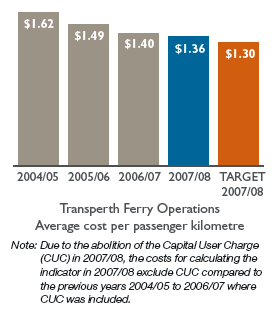
The 2007/08 result was 2.9% below 2006/07 result but 4.6% above the target for the year.
In 2007/08, the decline in average cost was due to passenger kilometre increasing from 547,119 in 2006/07 to 569,898 in 2007/08 despite total cost increasing by 1% from $765,000 in 2006/07 to $773,000 in 2007/08. The increase in ferry passenger kilometres was due to the inclusion of total fare - paying in the calculation instead of only two-section boarding as in previous years.
Transwa rail services
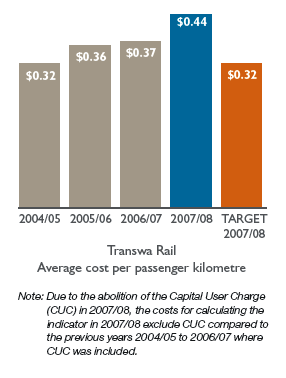
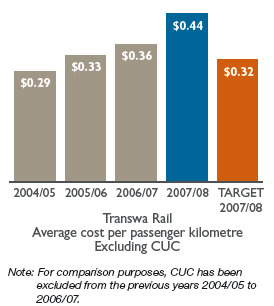
The 2007/08 result was 22.2% higher than 2006/07 and 37.5% above the target for the year. The cost per passenger kilometre was higher in 2007/08 mainly due to additional maintenance of the rail cars and increased depreciation as a result of the rolling stock revaluations coupled with the declining passenger numbers on rail services.
Transwa road coach services
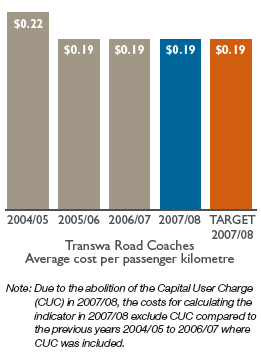
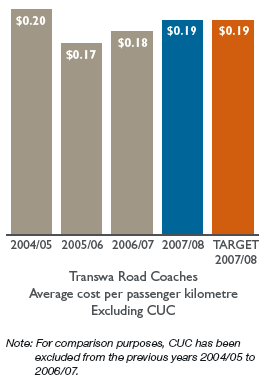
The average cost per passenger kilometre in 2007/08 was slightly higher than the 2006/07 result due to increased depreciation as a result of road coach revaluation coupled with the declining passenger numbers on road coach services.
2. Average cost per 1000 place kilometres
Note: This efficiency indicator was not audited in the previous years 2004/05 to 2006/07.
This indicator measures the cost efficiency of providing the service per 1000 place kilometres and it is calculated for each mode by dividing total cost by place kilometres.
Place kilometres are calculated by multiplying the average fleet capacity by the service kilometres.
A declining trend indicates that capacity is being provided at a lower cost and that services are being provided more efficiently.
Transperth train services
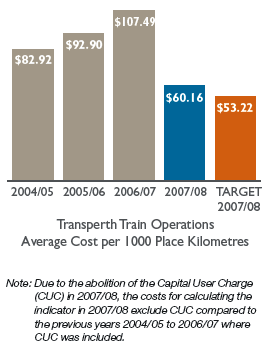
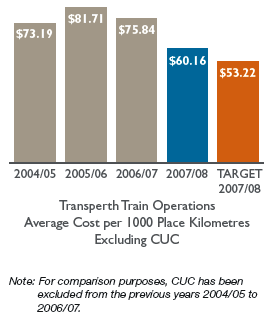
The half-year impact of high-frequency services on the longer Mandurah Line increased train passenger place kilometres. As a result the average cost per 1000 place kilometres on train decreased by 20.7% in 2007/08 compared to 2006/07 but was 13% over target.
Passenger place kilometres on the train network increased by 53.4% from 2,998.3 million in 2006/07 to 4,600.8 million in 2007/08. The increase in passenger place kilometres combined with a lower percentage increase in costs of 21.72% from $227.398 million (excluding CUC of $94.881 million) in 2006/07 to $276.780 million in 2007/08 contributed to the decrease in the average cost per 1000 place kilometres in 2007/08.
The target was exceeded because it was based on 5,425.7 million passenger place kilometres expected to be achieved if the Mandurah Line commenced operations in August 2007 with a projected total expenditure of $288.7 million.
The Mandurah Line started operations in December 2007.
Transperth bus services
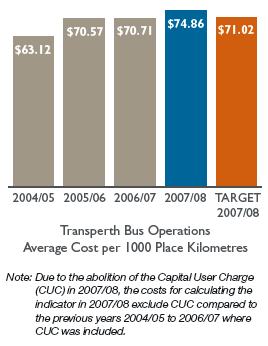
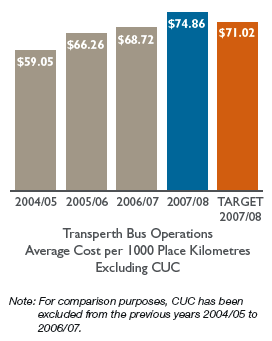
Total cost per 1000 passenger place kilometres on bus services increased by 8.9% (excluding CUC) in 2007/08 compared to 2006/07, and was 5.4% above target. Total passenger place kilometres on the bus network increased by 1.3% from 3,592.5 million in 2006/07 to 3,637.6 million in 2007/08 but total costs rose 10.3%, from $246.860 million (excluding CUC of $7.182 million) to $272.315 million, resulting in average cost exceeding both the 2006/07 result and the 2007/08 target. The increase in place kilometres was outstripped by the increase in total costs. Timing of the new southern bus network start-up impacted the target estimate. The target was based on 3,671.9 million passenger place kilometres expected to be achieved if the Mandurah Line commenced operations in August 2007 and projected total expenditure of $260.8million.
The Mandurah Line started operations in December 2007.
Transperth ferry services
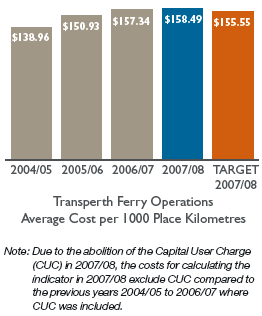
In 2007/08, total cost per 1000 passenger place kilometres on the ferry service increased 0.7% over 2006/07 and was 1.9% over target. Ferry passenger place kilometres increased marginally from 4.86 million in 2006/07 to 4.88 million in 2007/08 while total costs rose by 1.0% from $765,000 in 2006/07 to $773,000 in 2007/08. The target was based on total costs of $756,000 and 4.86 million passenger place kilometres.
Regional town bus services
a. Intra-town services
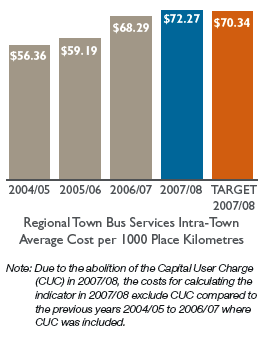
The 2007/08 result was higher than target as a result of the following:
- the cost of the rollout of the Transperth Wayfarer Ticket Machines on to the regional bus fleet was not identified and taken into account when the target was set up and the average cost in 2007/08 included the costs for the new ticketing equipment fitted on the buses in Kalgoorlie; and
- the introduction of two new low floor buses in Bunbury in accordance with the current contract between the PTA and Bunbury City Transit.
b. Inter-town services
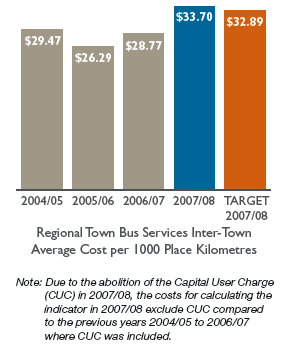
The 2007/08 result was higher than target due to the additional costs associated with the subsidisation of the services from Kalgoorlie to Laverton.
Transwa rail services
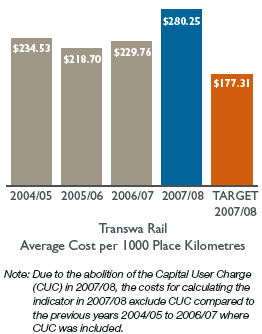
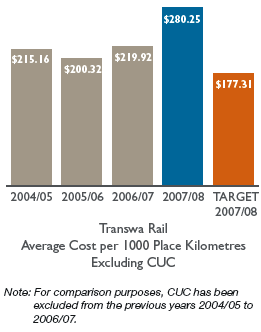
The cost per 1000 place kilometres in 2007/08 rose significantly mainly due to the effect of increased depreciation and the additional maintenance of the rail cars coupled with reduced placed kilometres as a result of the partial reduction in Prospector rail services.
Transwa road coach services
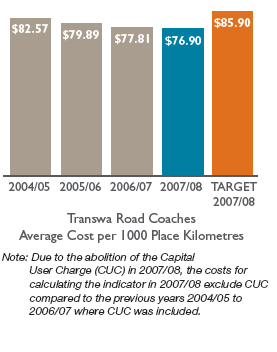
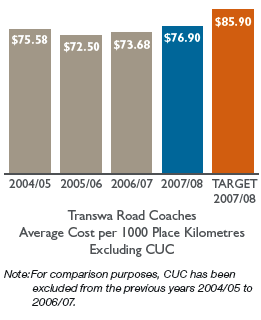
The 2007/08 result was 4.4% above the 2006/07 due to higher than expected maintenance costs.
Regional school bus services
The cost efficiency measure for school bus services measures the cost of funding student place kilometres provided to meet student requirements.
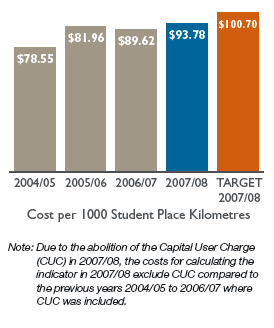
The 2007/08 results as compared to 2006/07 showed an increase of 4.6% in the cost per 1000 place kilometres. The factors which contributed to the increase were a combination of the following:
- continued growth in service levels driven by increase in students patronage and contract kilometres;
- seat belt implementation; and
- additional service days in 2007/08.
3. Total passenger place kilometres (millions)
Note: This performance indicator was not audited in the previous years 2004/05 to 2006/07.
This effectiveness indicator measures the total number of passengers that can be carried for the service kilometres.
It is calculated for each mode of transport by multiplying the average fleet capacity by the service kilometres and this represents the capacity provided on each mode.
Transperth train services
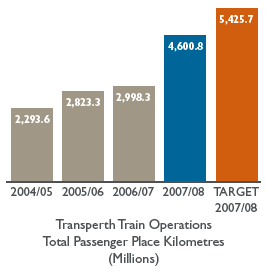
Passenger place kilometres on the train network increased by 53.4% in 2007/08 compared to 2006/07 following the commencement of services on the Mandurah Line. However, the 2007/08 result was 15.2% below target. The target assumed that operations on the Mandurah Line would commence in August 2007.
The Mandurah Line started operations in December 2007.
Transperth bus services
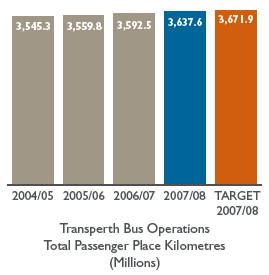
Passenger place kilometres on the bus network increased by 1.3% in 2007/08 compared to 2006/07 reflecting the expanded capacity being provided in the southern suburbs by bus feeders following the commencement of services on the Mandurah Line. However, the annual result was 0.9% below target. The target was based on the expectation that operations on the Mandurah Line would commence in August 2007.
The Mandurah Line started operations in December 2007.
Transperth ferry services
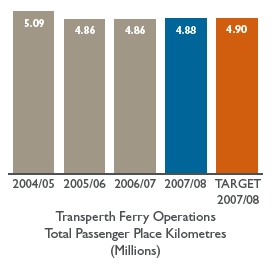
Ferry passenger place kilometres increased from 4.86 in 2006/07 to 4.88 in 2007/08 and was marginally lower than the target.
Regional town bus services
a. Intra-town services
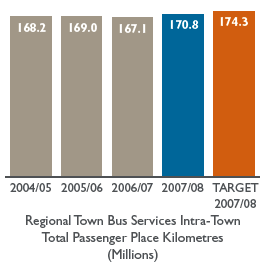
The 2007/08 result was lower than target as a result of the decrease in service kilometres in Bunbury, Port Hedland and Geraldton due to the implementation of route efficiencies in these towns.
b. Inter-town services
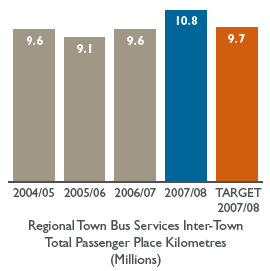
The 2007/08 result was higher than 2006/07 as a result of the introduction of the service between Kalgoorlie and Laverton.
Transwa rail services
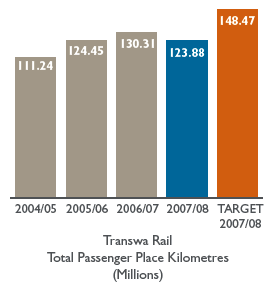
The 2007/08 result was 16.6% below target due to the reduction in Prospector rail services arising from track works on the Eastern Goldfields Railway and the reduced capacity of Australind services due to railcar refurbishment.
Transwa road coach services
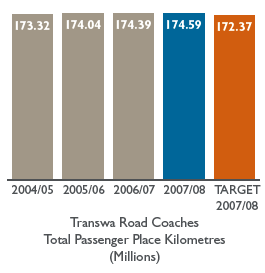
The slight increase in total passenger place kilometres for road coaches in 2007/08 reflected a change in passenger travel patterns.
Regional school bus services
The student bus service passenger kilometre is calculated by multiplying the average fleet capacity of the bus with the service kilometres. This indicator measures the total number of students that can be carried for the service kilometres.
An increase in the use of school bus services is measured by comparing the annual number of student bus service place kilometres.
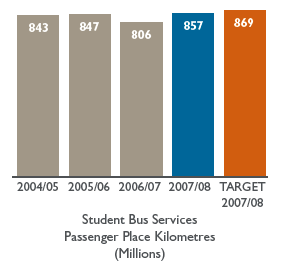
The 2007/08 result showed a 6.3% increase in place kilometres compared to 2006/07.
The factors which contributed to the increase in 2007/08 were a combination of sustained growth in service levels driven by increase in students’ patronage and contract kilometres, seat belt implementation and additional service days.
Passenger place kilometres was below target in 2007/08 due to the following factors:
- delays in the implementation of new services. A full year operating cycle was assumed when the target was set up; and
- over-estimation in the number of additional services and service kilometres emanating from the seat belt program.
